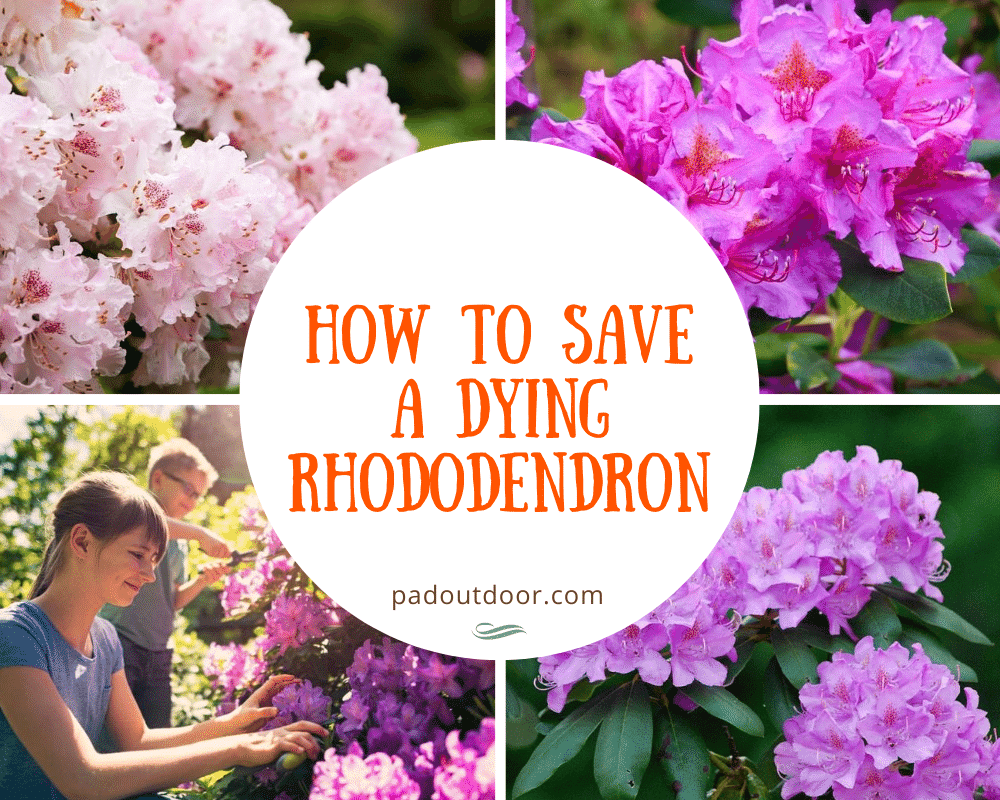If your Rhododendron is dying, don’t worry because there are ways to save it. Our guide has some of the best tips on how to save a dying rhododendron.

If you want a beautiful plant that can survive for many long years, then the Rhododendron is the best one for you. They’re extremely breathtaking and come in various warm colors such as dark red and purple. While they’re a sight to behold, they do have one weakness– they’re prone to certain diseases.
They’re pretty vulnerable to root rot and diseases that come from insects. If not addressed, these diseases may kill your plant. Luckily, there are ways on how to save a dying rhododendron.
If you happen to be having some rhododendron problems, follow these steps on how to revive a dying rhododendron:
Care Tips On How To Save A Dying Rhododendron
1. Look For Any Dying Tissue
The first thing you’ll want to do is look for dying tissue and prune them away. The dying tissues are extremely taxing on your plant, which is why you need to take them out. This is an extremely important step, especially if you see your rhododendron losing leaves.
2. Look For Unhealthy Leaves
If you happen to see any leaves that look yellow or have big veins around them, then you need to spray iron to those leaves since this is a sign of lacking iron.
3. Kill All The Insects Around The Plant
The next thing that you now need to do is make sure that there are no insects around the plant. In order to do this, you have to spray your plant with some safe insecticides. However, you need to make sure to be careful when using insecticide because if there is an existing infestation, then it means your plant is already sick.
If you add some insecticide to it, you might accidentally kill your plant. So, you must either be really careful when using insecticides or use a natural insecticide so your plant won’t be affected so much.
4. Make Sure You Put Your Plant Under Sunlight
When your plant is dying, you need to make sure it gets enough sunlight for it to heal. That said, you need to make sure that you move it to a place that has direct exposure to sunlight. However, you also need to take into consideration the time you move it to a place of sunlight. Direct sunlight after morning may burn the leaves so you need to ensure that the plant has some sort of shade during the afternoon. The only time to expose the plant to direct sunlight is during the morning.
5. Change The Soil
If you find your rhododendron dying after planting, then you may want to change the soil. You see, a rhododendron won’t do that well if the soil takes in and keeps too much water. This kind of plant will do better in a slightly wet but loamy soil. If ever the soil keeps water, then the roots will rot away.
So, how do you know whether your plant’s soil is good or not?
Well, the first thing to do is to wet the soil and pinch it. If ever the soil stays in the position at which you pinched it, then it might be a soil that retains too much water. Another way to confirm is to feel the texture of the soil. If it feels like clay, then you’ll have to change the soil.
6. Look Out For Fungus
Lastly, you need to check for any fungus. If you see any disease, then it’s best that you use some fungicides so that you can help your plant become healthy again. This is one of the best ways to revive your plant. It’s best to use fungicide during the late summer and spring because these times are the best for the plant’s recovery.
Conclusion
If you follow these steps, you’ll know exactly how to save a dying rhododendron. As you can see, the steps aren’t that hard to follow. And the best part is that they are extremely effective. With these steps, you now have the answer to, “how do you bring a rhododendron back to life?”
What else is there left to do? Well, all you need to do is simply apply this guide if ever you happen to have a rhododendron that isn’t in good shape.
Recommended Reading:
- How to Ripen Apples Faster (The Sweetest and Effective Tips So Far 2020)
- How to Get Rid of Sand Spurs (2022 Guide)
- How to Tell if Broccoli Is Bad (3 Indicators)
- How to Trim an Oak Tree without Killing It (Dos and Don’ts)







